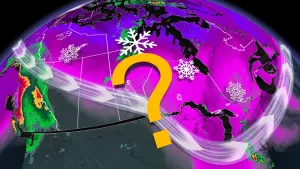
Draft flood maps for Greater Montreal show far more homes at risk
The number of properties located in flood zones is expected to increase significantly in Greater Montreal, especially in municipalities in the north of the island, according to the Communauté métropolitaine de Montréal (CMM).
The CMM, which represents 82 Montreal-area municipalities, adopted a preliminary report and a new flood map on Monday for the Greater Montreal area, which follow the Quebec government's guidelines for assessing flood risks.
Based on the CMM's updated flood maps, 15,508 buildings in Greater Montreal would be in flood zones. That corresponds to 19,780 residences and $9.9 billion in property value, Nicolas Milot, CMM director of ecological transition and innovation, told reporters last Friday.
The province's flood zone maps were last updated in 2019. Quebec is expected to publish new ones by the spring of 2025 as part of a new flood-management plan.
Previously, Quebec divided flood zones into two categories: high-risk zones (areas with a five per cent chance of flooding each year) and low-risk zones (one per cent chance of flooding).
RELATED: Basement-free buildings are better for the future climate
In draft regulations, Quebec is proposing a classification system based on four types of flood risks (very high, high, moderate or low).
The flood risk (from low to very high) is defined according to two criteria: the likelihood of flooding in the coming years and potential water levels.
Climate change behind flood-zone extension
The expansion of flood zones in Greater Montreal is mainly due to three factors, according to the CMM.
First, the updated map includes data on major flood events in 2017, 2019 and 2023.
As required by the Quebec government, the updated flood zones must "take into account the uncertainty linked to climate change," which is expected to increase the frequency of floods in the coming years.

Nicolas Milot is the Communauté métropolitaine de Montréal director of ecological transition and innovation. (Radio-Canada)
Changes also "take into account the failure of dams and reservoirs," and other structures that help mitigate the severity of floods. For example, Sainte-Marthe-sur-le-Lac, which is protected by a dike that burst in 2019 flooding, is considered to be in a flood zone for the first time.
Flood zones are expanding, but that extension is "occurring differently" across the territory, Milot said.
For instance, it is less notable along the St. Lawrence River when compared to the Lake of Two Mountains, the Rivière des Mille Îles and the Rivière des Prairies, Milot said.
Some places where flood zone expansions are more pronounced include Laval, riverside municipalities like the MRC of Deux-Montagnes (Pointe-Calumet and Sainte-Marthe-sur-le-Lac), Montreal's Pierrefonds-Roxboro borough and Vaudreuil-Dorion in Montérégie.
"In Greater Montreal, there are about 25 municipalities that really have to live with a flood risk dynamic that is very present, especially in the spring," Milot added.
Laval currently has some 1,100 flood-prone buildings on its territory. The update would increase that number to about 1,450, for a total of roughly 2,550 at-risk buildings.
Across Quebec, the draft regulation estimates that nearly 77,000 homes (or two per cent of Quebec's population) will be located in a flood zone, compared to 22,000 today.
Impact on property value
Quebec's regulatory analysis estimates that across the province, properties located in a zone where the risk of flooding is very high will suffer a loss in property value of four per cent.
However, Milot said the decrease is largely underestimated.
"The problem with this assessment is that it only looks at the effect of the regulation," he said. "Besides the regulation, there are other tools, other policies, other programs that have an impact on property values."
Quebec readjusted its financial assistance program for flood victims in 2019. In the event of successive floods, coverage is limited to $100,000 per property.
But the cap on compensation has led some mortgage lenders like Desjardins Group to stop financing the purchase of homes located in high-risk flood zones.
October outlook: Summer slowly fades, but consistent cold is delayed
In high-risk zones, "either we have people who are individually capable of bearing this risk [of flooding], or we will have to think about relocating them," Milot said.
Jim Beis, borough mayor of Pierrefonds-Roxboro, says the change to flood-zone maps will affect nearly 1,800 homes in his district, which he says marks an increase of about 70 per cent.
"People that were never in this map before, now, all of a sudden will find themselves in this eventual new map, so it is quite concerning," Beis said.
The mayor said that since 2017, he has called for the installation of permanent structures to protect residents from any risk of flooding but "none of that has been done."
In his view, presenting a map that identifies zero-risk areas across the province is an example of the CMM "taking the easiest way out."
"From zero to potential, there is some work to be done there to try to find some solutions," he added.
The Quebec government's public consultation on its flood-management framework launched last June and will end on Oct. 17.
This article was originally published for CBC News. Based on a report by Radio-Canada's Sandrine Côté with files from Alison Northcott and Sarah Leavitt, prepared by Holly Cabrera









